Người con của xứ Catalan từ nhỏ đã khác người, ít chơi với trẻ em đồng trang lứa mà có một thế giới của riêng mình và đắm chìm trong đó. Antoni Gaudí say sưa với những nét đẹp của tự nhiên, chiêm ngưỡng những dáng hình của cây, cỏ, lá, cấu trúc xương của các loài động vật… để sau này dựa vào những thiết kế thần kỳ của thiên nhiên ấy mà sáng tạo ra hàng loạt tác phẩm kiến trúc độc đáo và ấn tượng của riêng mình.
Giữa những dãy phố san sát nhà cửa hầu như theo một môtip từa tựa nhau với những đường thẳng kinh điển của tường, cửa, bancông, các biệt thự do Gaudí thiết kế trở nên thật nổi bật, gây ấn tượng cực mạnh, thậm chí khiến không ít người thấy sốc.
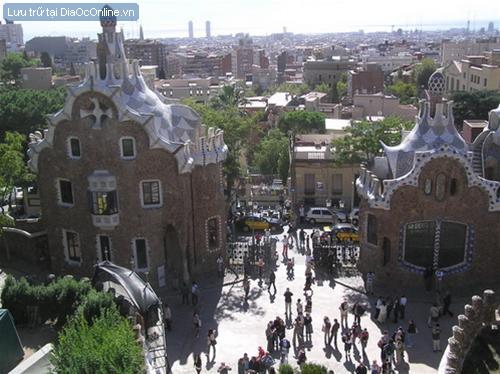
Thế giới cổ tích cho trẻ em ở công viên Güll - tác phẩm hoành tráng của Gaudí
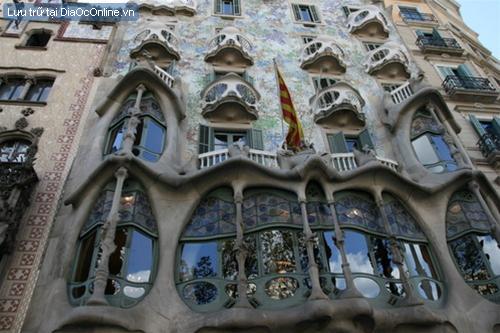
Mặt tiền Casa Battló nổi bật giữa phố
Hai công trình ấn tượng không kém công trình thế kỷ - nhà thờ Sagrada Familia của Gaudí ở Barcelona là Casa Batlló và Casa Milà. Cả hai ngôi nhà đều được UNESCO đưa vào danh sách di sản thế giới và hiện là sở hữu tư nhân nên vé vào khá đắt, khi chúng tôi vào giá vé ở Casa Batlló là 16,50 euro.
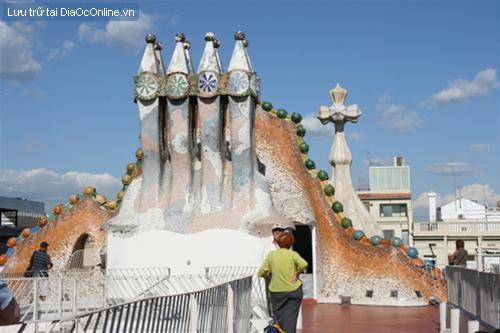
Hình ảnh con rồng được Gaudí thể hiện dưới nhiều dạng, có ai nghĩ rằng đây là cụm ống khói trên mái nhà Casa Battló
Casa Batlló có mặt tiền sặc sỡ của một bó hoa mùa xuân đủ màu tóe khắp tường, khắp bao lơn với những họa tiết thật đặc sắc làm nổi bật cả góc phố nơi nó tọa lạc. Tại đây Gaudí đã dùng những motip tự nhiên để tạo nên những ô cửa sổ hay bancông hình con mắt hoặc những phần lồi của tường như những cái mũi.
Đặc biệt ấn tượng với tôi là sự bài trí của các phòng cũng như những chi tiết độc đáo mà có lẽ chỉ Gaudí mới nghĩ ra và tạo nên chúng. Từ những cái cửa, chiếc gương cho đến trần nhà... vật dụng nào cũng làm người ta liên tưởng tới thiên nhiên hiện hữu quanh mình.
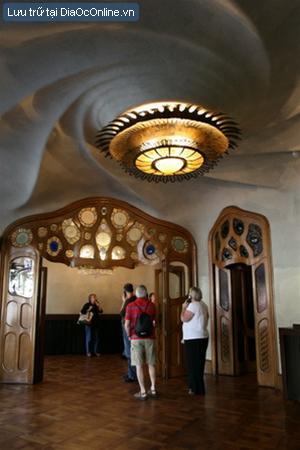
Khung cảnh và đèn trần độc đáo trong Casa Battló

Trẻ em đi dọc hành lang Casa Battló có thể ngỡ mình đang ở một lâu đài cổ tích
Hoành tráng hơn nữa là Casa Milà. Bên ngoài không màu mè như Casa Batlló nhưng cũng khá ấn tượng với những đường nét uốn lượn và những bancông độc đáo cùng những lan can sắt đủ hình dạng khác nhau.
Như có ai đấy vặn vẹo cả chuỗi bancông khiến chúng uốn lượn tựa như một giàn dây leo đang chực đổ. Đứng từ phía khác nhìn đám bancông ấy lại như đang mọc thêm tay vươn dài khắp nơi. Đấy là mặt hướng ra đại lộ trung tâm của biệt thự Mila (hay còn gọi là La Pedrera - đống hổ lốn, biệt danh mà dân Barcelona thời đó ưa gọi biệt thự này).

Casa Milà sừng sững trên phố với bancông và những hàng cột không giống ai
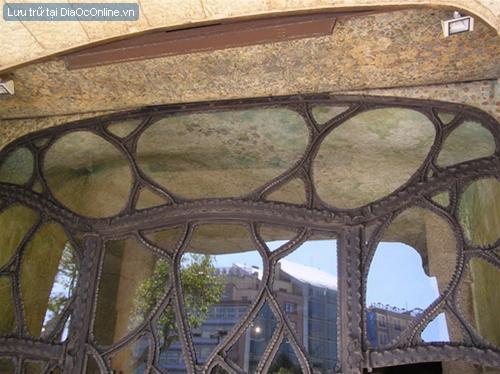
Khung cửa bằng sắt tựa như cây xương rồng khổng lồ uốn éo
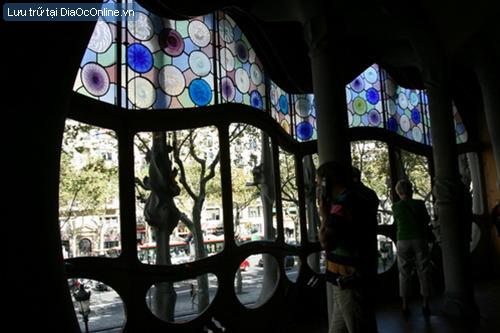
Kính màu và kính trong kết hợp với khung sắt uốn và phố xá tấp nập bên ngoài làm nên bức tranh sinh động cho người trong nhà
Ấn tượng và thú vị nhất ở ngôi nhà này là mái nhà với hàng loạt cột ống khói và ống thông khí với nhiều hình thù, màu sắc và độ lớn nhỏ. Những chi tiết hay đường nét kiến trúc trong các công trình kiến trúc Antoni Gaudí tạo nên thoạt đầu tưởng chừng quái đản và chẳng mấy logic, nhưng thật ra là cả một sự quan sát rất tinh tế của ông với vạn vật xung quanh.
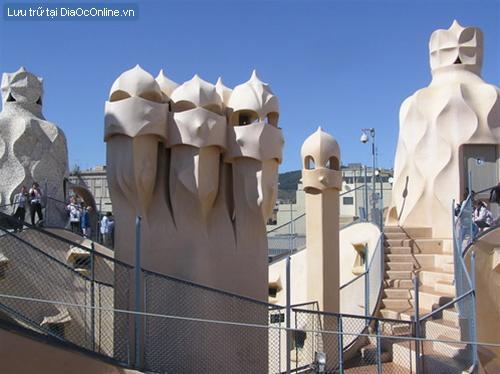
Những cụm ống khói dáng hình độc đáo đến kỳ lạ la liệt trên mái nhà Milà khiến người ta sững sờ
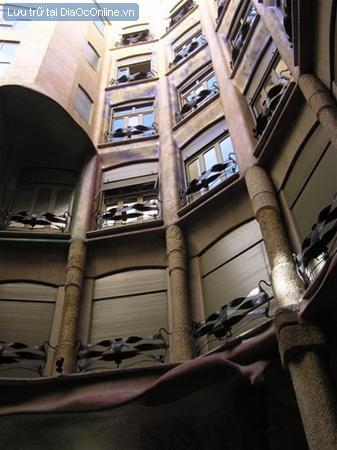
Đứng trong sân trời Casa Milà nhìn lên khối nhà đằng sau của tòa biệt thự
Một công trình nữa của Gaudí được UNESCO đưa vào danh sách di sản thế giới ở Barcelona là công viên Güll, nơi du khách có thể nghỉ ngơi dưỡng đôi chân sau những ngày rạc cẳng trên những đại lộ, những thắng cảnh của Barcelona trong không khí xanh mát của công viên, và còn thỏa mắt chiêm ngưỡng những chi tiết tạo hình trên hàng dãy ghế đá cạnh các bao lơn, những tháp nhà là những bức họa mosaic motip khác thường.
Đến công viên này bạn sẽ có cảm giác như đang lạc vào vùng đất cổ tích dành cho trẻ nhỏ. Mọi dáng hình của tự nhiên đều được mô phỏng khéo léo trong các thiết kế của Gaudí, bởi ông tôn thờ vẻ đẹp tự nhiên, luôn tìm tòi, chắt lọc những gì tạo hóa ban sẵn cho con người và mang chúng vào hòa cùng ý tưởng nhân tạo.

Công viên Güll là điểm đến ưa thích của cả người lớn và trẻ nhỏ, thỏa mắt nhìn với đa dạng hoa văn mosaic
Khi đi bộ trên phố, những thiết kế đèn đường và ghế trên vỉa hè của Gaudi cũng khiến bất kỳ khách bộ hành nào cũng muốn thả mình xuống và sờ tay vào từng đường lượn, những hoa văn cầu kỳ lạ mắt.
Chưa hết, bạn đừng quên ngắm những ngọn đèn đường yêu kiều cong mình chiếu sang qua những bóng đèn hình quả cầu màu trắng sữa trang trí hoa văn hình dây kiểu cách bao bên ngoài. Đừng bỏ qua những viên gạch lát vỉa hè, cũng là thiết kế của Gaudi đấy! Tôi đồ rằng chẳng có hè phố nào đẹp và kiểu cách như những con phố tráng lệ của Barcelona do trí tưởng tượng, mắt tinh tường và tài nghệ phi thường của Gaudí đã vẽ.

Đèn đường duyên dáng của Gaudí đem lại vẻ diễm lệ cho Barcelona
Đến Barcelona, để mơ mộng với Gaudí, để lạc vào cõi mộng của ông và thấy lòng mình thật thanh thản lạ kỳ. Chắc chắn người lữ khách có những giấc mơ đẹp đẽ giữa không gian Barcelona sau cả ngày du hành giữa những công trình quá ư lãng mạn mà duyên dáng của người kiến trúc sư đã gắn tên mình với thành phố vùng Catalan này...

Gaudí như vẫn ngồi đây nhâm nhi cà phê và thả hồn vào những thiết kế lấy tứ từ tự nhiên